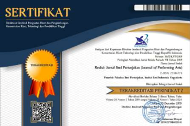Integrating Tradition and Technology: Digital Audio Workstation-Based Learning for Traditional Music Preservation
Abstract
Keywords
Full Text:
PDFReferences
Amin, S., Alwi, A., & Zainal, A. (2018). Challenges of Implementing E-Learning in Rural Areas of Developing Countries: Lessons Learned from a Case Study in Indonesia. Journal of Computer Assisted Learning, 34(6), 756-768.
Asogwa, C. E. (2020). Internet-Based Communications: A Threat or Strength to National Security. Sage Open, 10(2). https://doi.org/10.1177/2158244020914580
Bandura, A. (1977). Social Learning Theory. New York: General Learning Press.
Bartolome, S., & Steffe, L. (2018). Technology-Enhanced Music Education: A Comprehensive Review. Journal of Music, Technology & Education, 11(2), 141-160.
Bianchi, D., Avanzini, F., Baratè, A., Ludovico, L., & Presti, G. (2021). A GPU-Oriented Application Programming Interface for Digital Audio Workstations. IEEE Transactions on Parallel and Distributed Systems, PP, 1-1. https://doi.org/10.1109/TPDS.2021.3131659.
Born, G. (2010). For a relational musicology: music and interdisciplinarity, beyond the practice turn: the 2007 dent medal address. Journal of the Royal Musical Association, 135(2), 205-243.
Bramantyo, T., & Sigro Tjaroko, W. (2021). Lagu dolanan dalam permainan tradisional sebagai strategi inovasi pendidikan sendratasik. Resital: Jurnal Seni Pertunjukan, 22(3), 127-136. DOI: https://doi.org/10.24821/resital.v22i3
Campbell, P. S. (2018). Digital Audio Workstations in the Undergraduate Music Curriculum: A Case Study. Journal of Music, Technology & Education, 11(1), 39-54.
Chang, B., Chen, G. D., & Hwang, G. J. (2019). Effects of Integrating Synchronous Music Learning Support with Digital Musical Instruments on Students' Music Performance. Computers & Education, 133, 1-14.
Dellavani, C. Y. D. W., Mulyanto, M., & Kurniadi, E. (2023). Aransemen Lagu Widodari Karya Denny Caknan sebagai Media Pembelajaran Musik Keroncong di SMK Negeri 8 Surakarta. Resital: Jurnal Seni Pertunjukan, 24(2), 146-156. DOI: https://doi.org/10.24821/resital.v24i2
During, J. (2005). Third millenium Tehran: Music. Iranian Studies, 38, 373 - 398. https://doi.org/10.1080/00210860500300762
Gohlke, K., Hlatky, M., Heise, S., Black, D., & Loviscach, J. (2010). Track Displays in DAW Software: Beyond Waveform Views. Journal of The Audio Engineering Society.
Govindan, R., & Anderson, D. P. (1991). Scheduling and IPC mechanisms for continuous media. ACM SIGOPS Operating Systems Review, 25(5), 68-80. https://doi.org/10.1145/121132.121147.
Gunara, S., Setiawan Susanto, T., & Cipta, F. (2022). The authenticity of music culture of Kampung Naga and Cikondang Indigenous people, West Java, Indonesia. AlterNative: An International Journal of Indigenous Peoples, 18(1), 26-36. https://doi.org/10.1177/11771801221084517
Hapsari, A. A., Rukayah, F. A., & Fatchurrohman, N. (2020). Digital Audio Workstation for Traditional Music Learning: A Preliminary Study. Journal of Arts and Humanities, 9(2), 01-12.
Hidayat, A. A. A. (2006). Pengantar Kebutuhan Dasar Manusia: Aplikasi Konsep dan Proses Keperawatan (Introduction to Basic Human Needs: Concepts and Application of Nursing Process). Jakarta: Salemba Medika.
Kartomi, M. (2008). Musik, Tari, dan Etnisitas di Indonesia: Mencari Bentuk. Jakarta: Yayasan Pustaka Obor Indonesia.
Liu, Y., Liu, C. C., & Hwang, G. J. (2022). Exploring the Effects of Digital Audio Workstation-Assisted Music Learning on Students' Creativity and Satisfaction. Computers & Education, 179, 104347.
McKean, T. (2003). Tradition as Communication. Oral Tradition, 18, 49 - 50. https://doi.org/10.1353/ORT.2004.0030.
Muhtar, S. W., Sunarmi, S., & Soewarlan, S. (2024). Strategi Konservasi Musik Angklung Masyarakat Kampung Naga di Kota Tasiklamalaya Jawa Barat. Resital: Jurnal Seni Pertunjukan, 25(1). DOI: https://doi.org/10.24821/resital.v25i1
Ogli, G. E. (2023). Heritage And Identity in Idoma Traditional Music. Journal of Tourism and Heritage Studies, 12(1). https://doi.org/10.33281/JTHS20129.2023.1.5
Overskeid, G. (2018). Do we need the environment to explain operant behavior?. Frontiers in Psychology, 9, 373. https://doi.org/10.3389/fpsyg.2018.00373
Pendergast, S. (2021). Creative Music-Making with Digital Audio Workstations. Music Educators Journal, 108(2), 44-56. https://doi.org/10.1177/00274321211060310
Shelemay, K. (1996). The Ethnomusicologist and the Transmission of Tradition. The Journal of Musicology, 14, 35-51. https://doi.org/10.2307/763956.
Smith, J., Brown, A., & Johnson, D. (2021). Digital Music Making: Examining the Impact on High School Students' Technology Skills. Journal of Research in Music Education, 69(2), 195-215.
Steers, R. M. (1975). Problems in the measurement of organizational effectiveness. Administrative science quarterly, 546-558.
Susanto, H. (2019). The Role of Contextual and Participatory Approaches in Teaching Traditional Music in Indonesia. International Journal of Music Education, 37(4), 589-602.
Tarnawska-Kaczorowska, K. (1998). Musical quotation an outline of the problem. Contemporary Music Review, 17, 69-90. https://doi.org/10.1080/07494469800640211
Utami, D., Purwitasari, D., & Santosa, P. I. (2023). Community Perspectives on the Use of Digital Audio Workstation in Traditional Music Learning: A Case Study in Cisaat Village, Subang. International Journal of Music Education (In press).
Vygotskiĭ, L. S. (1987). The collected works of LS Vygotsky: Volume 1: Problems of general psychology, including the volume Thinking and Speech. Springer Science & Business Media (Vol. 1).
Waddell, G., & Williamon, A. (2019). Technology use and attitudes in music learning. Frontiers in ICT, 6, 11.
Walzer, D. (2020). Blurred lines: Practical and theoretical implications of a DAW-based pedagogy. Journal of Music, Technology and Education, 13, 79-94. https://doi.org/10.1386/jmte_00017_1.
Whiting, J., Fortney, K., Neilsen, T., & Gee, K. (2014). Software usage for synthesized sound in acoustics education. Journal of the Acoustical Society of America, 135, 2159-2159. https://doi.org/10.1121/1.4877005.
DOI: https://doi.org/10.24821/resital.v25i2.13913
Refbacks
- There are currently no refbacks.
This work is licensed under a Creative Commons Attribution 4.0 International License.




